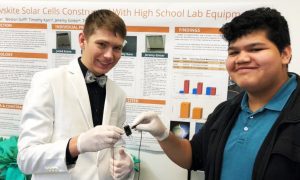This post provides a deeper look into the ideas of Equity of Opportunity, one of JumpRope’s Core Values.
Teacher collaboration is an essential tool in working toward equitable assessment across a school or district. It’s an investment we should make. In June we shared the fourth and final post in our latest series. Rubrics, Part 4: Reliability, describes three different types of reliability, the first two, test-retest reliability and parallel forms reliability, are easier to attain when we work collaboratively with colleagues. The third, inter-rater reliability, demands that we work together. Working together because there is no other way to complete the task is one reason to collaborate, but a study by Goddard, Goddard, and Tschannen-Moran (2007), “offers original evidence of a positive and statistically significant relationship between teacher collaboration and student achievement.” (891) Similarly, Vescio, Ross, and Adams write that their study of the literature on Professional Learning Communities indicates “resounding(ly)” that teacher participation in them increases student learning (2008). Goddard, Goddard, and Tschannen-Moran (2007) go on to say “the most important outcome of teacher collaboration may be that teachers learn how to improve their instructional practice… and (move) toward engagement with others around important questions of teaching and learning.” (892) On our best days, we want to believe that learning itself is the path and the destination, but we all know that many students and their families see scores and grades as the destination. Given that teacher collaboration improves student learning and teachers’ instructional practice, it seems logical to think that the same would be true of assessment practices.
One effective way for a school to improve assessment practices is endeavoring to combat phenomena like, “take American History with Ms. Greene, it’s an easy A” or, “Mr. Ansari’s 3rd graders always score higher on tests than do Mr. Sprague’s.” Mr. Ansari and Mr. Sprague would minimize and possibly even eliminate this situation if they worked together as opposed to in isolation. They’d have the opportunity to discuss their thought processes in assessing student assignments, and thus move toward some common understandings. It’s easier for teachers to reach these common understandings regarding their evaluation of student work if they first agree on what they should evaluate. Let’s return to a third grade mathematics standard Sarah Caban wrote about in 2016:
Tell and write time to the nearest minute and measure time intervals in minutes. Solve word problems involving addition and subtraction of time intervals in minutes, e.g., by representing the problem on a number line diagram.
As indicated by the three sample assessment problems Sarah shares in her post, each addresses a portion of the standard and each is written at a different rigor level. A conversation among teachers who teach and assess third grade mathematics would help them collectively interpret this standard and move toward agreement on how it could be assessed. This shared conception might lead to common assessment tools, or it might lead to common understandings of what each teacher should look for to determine proficiency levels among students. Then, as they actually consider student assessments, they can be more certain that Mr. Sprague’s conception of proficiency, for example, is better aligned with Mr. Ansari’s conception.

Building on this collaboration, as I describe in Rubrics, Part 4: Reliability, teachers could score student work together and compare those scores. If Mr. Ansari and Mr. Sprague did so, they’d be practicing inter-rater reliability and along the way, they’d undoubtedly engage in conversations which deepened their practice and moved them toward greater consistency. And finally, from there, in addition to improving their own assessment practices, the collective analysis of a particular summative assessment or group of assessments can indicate which standards or portions of standards should be revisited. Teachers can further collaborate regarding when and how to revisit instruction and assessment for those areas of concern. These practices ensure consistency among teachers as they strive to support all grade-level students. (Fenton and Murphy, n.d.)
Teacher collaboration is really about building collective understanding and searching for agreement as we strive to make our own practice and the practices across our school as good as they can be.
Teacher collaboration is really about building collective understanding and searching for agreement as we strive to make our own practice and the practices across our school as good as they can be. As I mentioned at the top of this post, this sort of teacher collaboration is an investment we should make. The investment is really multifold: administrators need to prioritize this work so teachers have time to engage meaningfully with one another and teachers need to be willing and maybe even eager to learn with one another. Since they will not always agree and sometimes may even sharply disagree, the collaborators should first invest time in establishing group norms that will help them listen without judgement and share without fear as they strive for consistency in their practice. Such an investment will bear positive results for the educators involved and for the students with whom they work.




